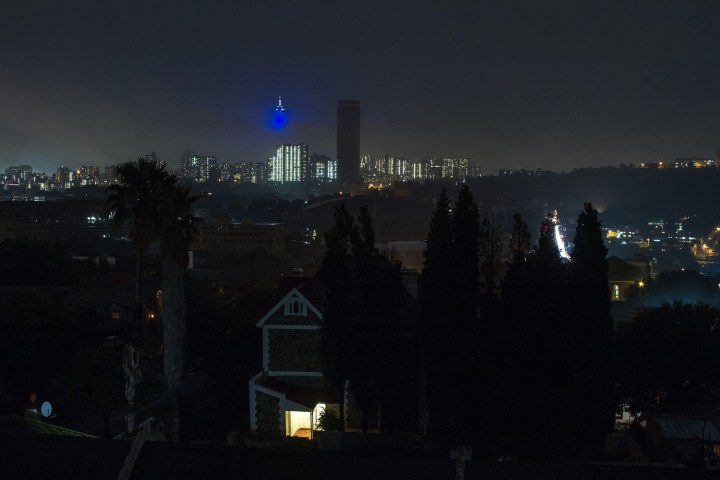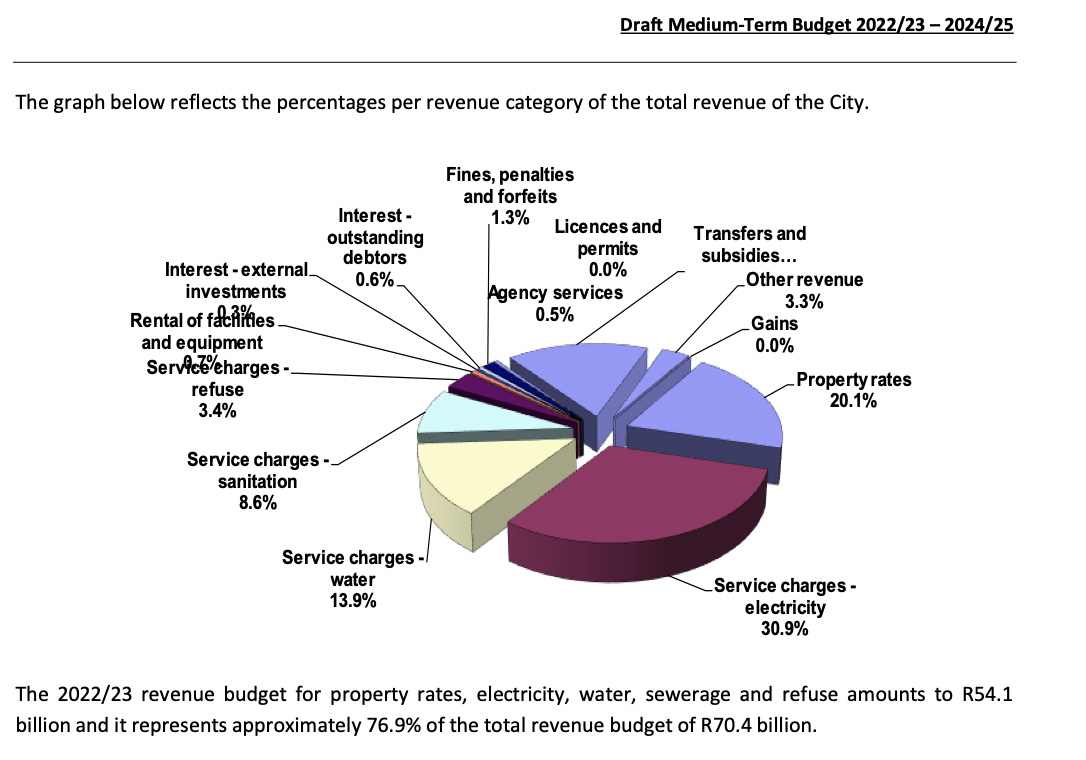POWER PREDICAMENT
Joburg residents sit in the dark for days as the city’s grid collapses

Now mayor Mpho Phalatse wants to cut the Eskom stranglehold by using more independent power producers.
Local councillors have told Johannesburg residents to expect to wait between two and five days to get their power back as the city grid collapses under the weight of almost daily scheduled power cuts by Eskom.
The graphic below shows that the social media reports by City Power for April and May revealed 192 additional outages. Even this is an undercount, according to Daily Maverick’s data investigation. Brixton, for example, is recorded as a single outage, but the area of several suburbs has outages at least twice a week, according to local WhatsApp groups.

The City’s mayoral committee member for infrastructure, Michael Sun, says Johannesburg is one of the most challenging electricity crises in the country. Stage 2 (Eskom load shedding) is Stage 4 in Johannesburg. The multiparty coalition government in the city wants to cut free from Eskom, and mayor Mpho Phalatse says the City is planning to urgently bring independent electricity onto the grid.
City Power’s grid buckles under the twin weights of age and power cuts. When Eskom sheds load, the constant switching on and off of the old city grid means it takes strain. The Sunday Times reported that 29 of the city’s 251 power transformers are older than 50 years and need to be replaced. Across the city, blackouts and scheduled power cuts make life miserable, and councillors warned at the weekend that it could take between two and five days to fix the grid system’s reported outages.
Dr Tim de Maayer, a paediatrician who works at the Rahima Moosa Women and Child Hospital in Coronationville, wrote here about how doctors have to use their phones for light in sensitive examinations of small children. The hospital is fed by the Hursthill depot, which the graphic shows is one of the worst in the city.
Outages that last for days are regular everywhere, from Soweto to Sandton, as one of Africa’s largest cities has lost access to stable and cheap electricity. The budget to be tabled this week has pencilled in an electricity increase of 9.61% (almost double the inflation rate) and 10% each for the next two years.
City Power is in a utility death spiral, and Phalatse knows she has to cut loose from Eskom. The two-day Indaba is part of her opening gambit to reshape Johannesburg’s energy future like mayor Geordin Hill-Lewis is doing in Cape Town, with a tender out to independent producers to source an additional 300 megawatts. The City of Cape Town already has a load shedding level lower than the rest of the country thanks to reliance on a hydroelectric plant at the Steenbras Dam which is used for “peak-lopping”.
Now Johannesburg is set to change direction, and to power purchase agreements it is allowed to do.
An entire working month lost to load shedding in 2022 as Eskom’s head of generation resigns
City Power chairperson Douglas Gibson says the utility that runs electricity in the city will change from being only a generator of Eskom power to an energy provider. This is a tremendous ideological change from how the ANC ran Johannesburg for decades to ramp up revenue for the city by using only the monopoly supplier, Eskom. About 30% of the City’s income comes from levies added to the bulk price it pays for electricity.

“It’s an area we have hogged for far too long. Our revenue is dependent on electricity, but if we lose our ratepayers (residents who can are increasingly making their plans), you lose generation capability anyhow. You can’t be an economic hub without a regular power supply,” said Phalatse.
It will take R26-billion to recapitalise City Power to make essential repairs, and the entire city has an R7-billion Capex budget for the year. The private sector is going to have to fill the gap.
“There is no way we can turn around energy supply (on our own),” said Phalatse.
The energy options being explored by the city are gas, rooftop photovoltaic installations, biogas and biomass, and wind and solar. Phalatse said Johannesburg would use municipal laws which allow governments to diversify energy supply with limited regulation. DM
[hearken id=”daily-maverick/9472″]
















 Become an Insider
Become an Insider
But what does uncle Gweezy have to say about all of this?
One obvious item not considered is making it obligatory that houses are better insulated. All new build houses should be forced to insulate to achieve energy savings, particularly in terms of concrete floor slabs.
advice to residents : sort most of your own needs out rather than waiting for government and council. It will be faster and cheaper and more reliable.
The only way to go. The city really needs to go into maximum overdrive on this one.
South Africans are suffering so that corrupt big business can profit !!!
How Eskom was fleeced: Kusile and Medupi tenders ballooned from R200m to more than R20bn
Sipho Masondo and Juniour Khumalo 2020-03-15 22:30
Contingency budgets, unapproved proposals and contractual variations went ahead willy-nilly, allowing tenders to morph from R200m to billions
Eskom has launched a series of investigations to determine how project management fees for the construction of two of its power stations, Kusile and Medupi, ballooned from R200 million to more than R20 billion.
In a presentation by Eskom’s chief procurement officer, Solly Tshitangano, to MPs last week, he revealed that during the mid-2000s, Eskom had contracted US engineering firm Black & Veatch at a cost of R200 million – but ended up paying the two firms more than R20 billion because of variations in the scope of work
Also attending the presentation was Eskom’s top brass, including board chair Malegapuru Makgoba, chief executive André de Ruyter
The source added: “In 2007, Eskom asked Black & Veatch to make a proposal detailing a ‘shopping list’ of all the services the firm could offer us. That is why, in September 2007, Black & Veatch’s contract increased from R100 million to R2.7 billion.
Remember who was in charge when this happened? Another ANC success story…
I remember meeting a number of Black and Veatch engineers at a local game park, who backed off with secrecy clauses in their contract, advised how they were directed to do many things against their will by political interference. Hearsay I know, but that is the bottom line. At the end of the day they are crucified with it, having worked on a corruption-ridden project and their CV’s will be blotted.
In South Africa, the poor pay the electricity bill of the world’s largest mining company
EJOLT collaborator Professor Patrick Bond recently published an article linking secret deals for almost free electricty for a mining giant with the explosion of electricity costs for ordinary users and community unrest all over the country as people are taken off the grid. Add the fact that profits are channeled to the headquarters in Australia and you have colonialism, 21st century style. His article is published in City Press, South Africa.
@dragan – the cause is ANC (…why is it that my spellchecker auto completes to “ancient”?) mismanagement and corruption. …and there are surely many hogs at the trough.
D.A.
I don’t have too much sympathy with JHB. Here in Hilton, KZN, we experience loadshedding, load reduction and constant repairs to the system. Daily. We have the curious anomaly here where we pay rates to uMngeni (Howick), Electricity to Msunduzi (Pietermaritzburg) and water to Umgungundlovu (district municipality). Of course Msunduzi loves the cash cow of regular electricity payments from the Hilton residents but since we have no pull as we are not rate payers we get left sucking the hind tit the whole time.